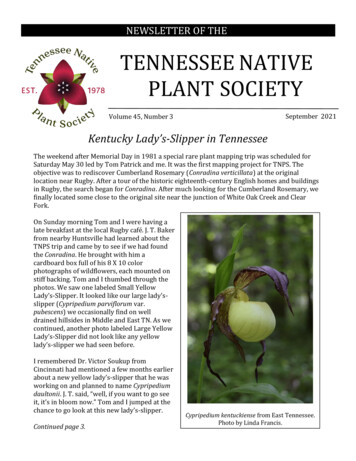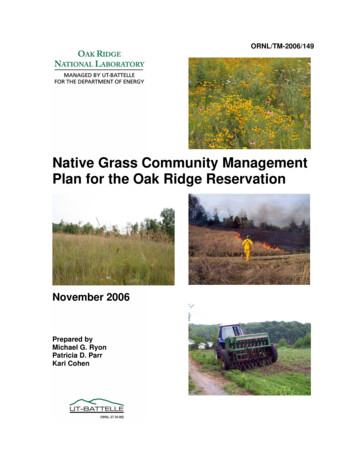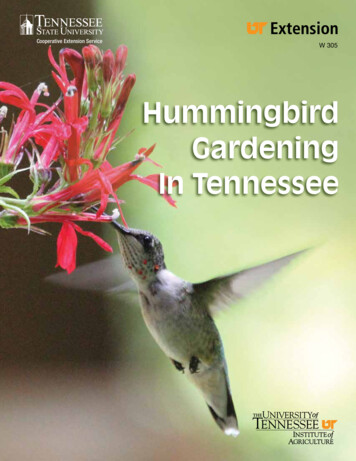
Transcription
NEWSLETTER OF THETENNESSEE NATIVEPLANT SOCIETYSeptember 2021Volume 45, Number 3Kentucky Lady’s-Slipper in TennesseeThe weekend after Memorial Day in 1981 a special rare plant mapping trip was scheduled forSaturday May 30 led by Tom Patrick and me. It was the first mapping project for TNPS. Theobjective was to rediscover Cumberland Rosemary (Conradina verticillata) at the originallocation near Rugby. After a tour of the historic eighteenth-century English homes and buildingsin Rugby, the search began for Conradina. After much looking for the Cumberland Rosemary, wefinally located some close to the original site near the junction of White Oak Creek and ClearFork.On Sunday morning Tom and I were having alate breakfast at the local Rugby café. J. T. Bakerfrom nearby Huntsville had learned about theTNPS trip and came by to see if we had foundthe Conradina. He brought with him acardboard box full of his 8 X 10 colorphotographs of wildflowers, each mounted onstiff backing. Tom and I thumbed through thephotos. We saw one labeled Small YellowLady’s-Slipper. It looked like our large lady’sslipper (Cypripedium parviflorum var.pubescens) we occasionally find on welldrained hillsides in Middle and East TN. As wecontinued, another photo labeled Large YellowLady’s-Slipper did not look like any yellowlady’s-slipper we had seen before.I remembered Dr. Victor Soukup fromCincinnati had mentioned a few months earlierabout a new yellow lady’s-slipper that he wasworking on and planned to name Cypripediumdaultonii. J. T. said, “well, if you want to go seeit, it’s in bloom now.” Tom and I jumped at thechance to go look at this new lady’s-slipper.Continued page 3.Cypripedium kentuckiense from East Tennessee.Photo by Linda Francis.
TNPS NewsletterLetter from the PresidentThis newsletter is a publication ofthe Tennessee Native Plant Societyand is published four times a year,generally inMarch, June, September,and December.The summer has flown by, with hikes and native plantseminars, but we still have a few more of each before theholidays. We will also have a brief Member Meeting via zoomon November 16th. Details are posted in this newsletter.The Tennessee Native PlantSociety (TNPS) was founded in1978. Its purposes are to assist inthe exchange of information andencourage fellowship amongTennessee’s botanists, bothamateur and professional; topromote public education aboutTennessee flora and wild plantsin general; to provide, throughpublication of a newsletter orjournal, a formal means ofdocumenting information onTennessee flora and of informingthe public about wild plants; andto promote the protection andenhancement of Tennessee’s wildplant communities.Dues for each calendar year are:Individual/Family: 20Student: ComplimentaryInstitution: 50Life: 250Dues may be sent to:Tennessee Native Plant SocietyP.O. Box 159274Nashville, TN 37215OfficersKaren Ripple Hill, PresidentAllan Trently, Vice-PresidentBettina Ault, SecretaryKim Sadler, TreasurerSusan Sweetser, Past PresidentDirectorsSuzy AskewLouise GregoryMichelle HaynesDennis HornBart JonesLarry PoundsHave you noticed all the beautiful colors now as the seasonchanges? I never tire of seeing the yellow goldenrod behindmy house. It’s so cheery as the days become shorter. Soonthe fall asters will be blooming too.Many new members have joined TNPS this year and we areexcited to have you all participate in any and all of ouractivities. One of the best ways to learn more about thepeople and activities of TNPS is to volunteer. Currently weneed volunteers for three very different roles: EducationOutreach (Middle-TN), Photo Librarian, and educator to helpus create an online course. None of these positions requiresexpert native plant identification skills.Education Outreach requires lots of interactionwith the public at a variety of events scatteredaround Middle-TN where we might recruit newmembers and/or sell a few books.The Photo Librarian is a new position for someonewith a tech background. As we digitize older slidesand then add digital images to the library, we willneed someone to organize the images and controlaccess to them.We are also forming a committee to create anonline course about native plants for middle schoolstudents using our digital images. A background asan educator would be helpful but is not required.If any of these roles sounds interesting to you or you wouldlike to know more, please send me an email atinfo@tnps.org.Did you know TNPS has a facebook page? If you need/wanta plant identified, that’s an easy place to post a photo andreceive feedback. Society
Continued from page 1.It turned out J. T. Baker was Senator Howard Baker’s first cousin. ButJ. T. had another first cousin near Huntsville that had this new lady’sslipper on his property down on a flood plain along the New River.Tom and I were excited to see this new lady’s-slipper. It certainlylooked like something new and different to us. Two months later thisspecies was described by Dr. Clyde F. Reed, and he named itCypripedium kentuckiense.This came as a huge disappointment for Dr. Soukup and Jim Daulton.Dr. Soukup had planned to name this lady’s-slipper for Daulton. Seethe following historical note by Dr. Carl Slaughter that appeared in theFall 1999 issue of the Arkansas Native Plant Society newsletter:Cypripedium kentuckiense ofwestern Tennessee. Photoby Bart Jones.Jim Daulton of Portsmouth, Ohio was on a fishing vacation in easternKentucky, in 1951, when he came upon a large, beautiful lady’s-slipper orchid.Jim knew enough botany to know that this was not the slipper that he knew. Itwas larger and bloomed later than the others that he knew. Daulton removedtwo plants to his home where they thrived and formed large clumps.Jim Daulton invited everyone he could think of to come and look at the orchid.A few came but no help was forthcoming. He did send a whole plant to Donovan S. Correll, who in 1938 hadpublished Native Orchids of North America and was the orchid guru at that time. Daulton did not receive areply from Correll.In 1977 Victor Soukup traveled from Cincinnati, Ohio, to Kentucky, where Daulton directed him to the originalorchid site. Soukup reported this find in a pamphlet of the Mid-American Orchid Conference. Soukup namedthe orchid after Jim Daulton, Cypripedium daultonii. Jim Daulton was ecstatic! After all the years and after allthe work just to have anyone look at it, not only had he succeeded in having people agree with him, but theorchid was also named for him. Oh, how sweet and wonderful! But wait, Victor Soukup had not followedproper procedure in the naming of the orchid. He had not described it in Latin.In 1981, Clyde Reed of Maryland published in Phytologia a proper Latin description with specimen citation ofa new orchid find which he called by a different name. It was the same orchid that Soukup had named C.daultonii. Since this name was invalid because of improper naming, what we would now be callingCypripedium daultonii, named by Victor Soukup, we now know as Cypripedium kentuckiense, the SouthernLady’s-Slipper named by Clyde Reed.Cypripedium kentuckiense is the largest yellow lady’s-slipper we have in the U.S. It has a pale-yellow lip(or moccasin) with a large opening (orifice) on the top and a sharp drop off at the toe. The sepals andlateral petals are deep purple or wine colored. It is found from Oklahoma and Eastern Texas, east toKentucky and Georgia. It is most common in Arkansas, Louisiana, and Kentucky, but is listed as rare inevery state where it occurs. It is most commonly found on alluvial terraces along small rivers or creeks. Ithas been found only in Decatur, Franklin, and Scott counties in Tennessee, one county in each ofTennessee’s three Grand Divisions.So, this year (2021) it has been 70 years since Jim Daulton realized he had found a new yellow lady’sslipper and now 40 years since Clyde Reed described Cypripedium kentuckiense as a new lady’s-slipperspecies.Dennis Horn
Cumberland Sandwort DelistedAfter more than three decades of conservation partnershipsinspired by the Endangered Species Act and a thorough review ofthe best available science, the U.S. Fish and Wildlife Service isdelisting the Cumberland sandwort due to recovery.“Partnerships are the key to the success of the EndangeredSpecies Act,” said Leopoldo Miranda-Castro, Service RegionalDirector. “Playing critical roles in the recovery of this delicateflower were the National Park Service, U.S. Forest Service, statesof Tennessee and Kentucky, Cincinnati Zoo and Botanical Gardenand Missouri Botanical Garden. Thanks to these efforts, futuregenerations will have the opportunity to enjoy the sandwort andthe plants and animals that share its habitat.”Found only in a small portion of the Cumberland Plateau innorthern Tennessee and southern Kentucky, the Cumberlandsandwort was headed toward extinction before it was listedunder the Endangered Species Act (ESA) in 1988. That’s when thestates of Tennessee and Kentucky, federal agencies andconservation groups stepped in to protect and restore this uniqueplant.At the time of listing, the Service was aware of only 28occurrences of the plant. The species faced threats from overuseor destruction of habitat from recreational activities in thesandstone cliff lines where it occurs. Land protection and habitatmanagement by diverse partners have been vital to protectingand recovering the sandwort.Cumberland sandwort, Arenariacumberlandensis. It normallyblooms in June and July.Conservation actions on behalf of the sandwort included installing signs, fencing and boardwalks toeducate visitors about public lands and plant protection. Today, sandwort populations are healthy andstable and are found in 71 places. Sixty-six of those occurrences are on federal and state conservationlands managed by the National Park Service, Tennessee Division of Forestry, Tennessee Division ofNatural Areas, or Tennessee State Parks. Pickett State Forest, owned by the Tennessee Division ofForestry, has 29 occurrences alone.Email notice from Daniel Elbert, Field Supervisor, Tennessee Ecological Services Field OfficeSouth Atlantic-Gulf Interior Region, USFWSFirst described to science in 1979 by Drs. Robert Kral of Vanderbilt University and Eugene Wofford of theUniversity of Tennessee from material they collected at Pickett State Park, Cumberland sandwort occursat the base and ledges of shady sandstone cliffs or rockhouses in four Tennessee counties and oneKentucky county. Its limited range and strict habitat requirements justified the species’ listing asendangered in 1988.Roger McCoy, Director of Conservation for the Tennessee Department of Environment and Conservation inThe Tennessee Conservationist, September/October 2020
Trip Report: Purple and Yellow Finale – September 11thWe usually have a fall outing to enjoy the end of the flowering season.This year, September 11, we climbed Cumberland Mountain east ofLafollette. We saw lovely yellow displays of sunflowers: Helianthusmicrocephalus, Helianthus glaucophyllus and a close relative Heliopsishelianthoides. A deep purple was added by clasping aster(Symphyotrichum patens).We also found two types of fruit of interest. Pawpaw (Asimina triloba)fruit is normally hard to find though this small tree is common. First,we found an unripe one then a few minutes later we got one with thefragrant smell for all to enjoy. Some people are attempting tocommercialize this fruit. Next, we happened on two butternuts lyingon the ground. The butternut or white walnut tree, Juglans cinerea, israre and rarer still is finding the nut. This tree is attacked byButternut Canker fungus leading to its rarity.Heliopsis helianthoidesIn planning for this trip, we tried to accommodate a variety ofinterests, length of time available and physical ability. I felt goodabout how the outing worked for people. The 12 of us turned back atseveral different points and we helped each other get past a landslidezone in the trail. For some the highlight of the trip was not the plantsbut the views from cliff tops. Thanks to Jimmy, Judy, and Ken for helpwith this. We enjoyed meeting new faces, Jack, Bruce, Linda, andSarah.Jimmy and I did a small service project on the hike gathering info ontwo rare plant populations found on top of the mountain. This datawas hand delivered to Todd our state botanist to put in the stateprotected plant database. Larry Pounds and photos by Ken MayesLobelia puberulaAureolaria laevigata
Trip Report: Thomas Divide-KanatiFork – July 17thFive hearty souls met on Saturday to car shuttle and hike thetrail. Allen and Susan had scouted the trail and provided a listof plants for the group. Plant identification was from thebeginning of the trail with the first occurrence of individualplants.Lillium superbumMonarda clinopodiaMargie Hunter, Bettina Ault, Harland Alpaugh and theSweetsers made up the group. Needless to say, we looked ateach and every plant, photographed and discussed theparticulars of each. With this going on, we didn't get very far onthe trail. Due to time constraints, a couple of us turned backand 3 went on for about a mile and half only.Some of the highlights were Featherbells (Stananthiumgramineum), Steele's Joe-Pye Weed (Eutrochium steelei),Painted Trillium (Trillium undulatum), Flame azalea(Rhododendron calendulaceum) and Rosebay Rhododendron(Rhododendron maximum) still in bloom. Turk's Cap lily(Lillium superbum), White Bergamot (Monarda clinipodia), CowWheat (Melampyrum lineare var. americana) and Purple bluets(Houstonia purpurea var. purpurea) were all blooming alongthe trail.Susan Sweetser and photos this page by Susan SweetserFall Virtual Wildflower PilgrimageUnfortunately, the Smokies’ annual Spring Wildflower Pilgrimage wascancelled for the second year because of concerns about Covid-19. Thesecond annual Spring Virtual Wildflower Pilgrimage, however, was agreat success, with 12,027 observations of 2537 species by 108observers. The second annual Fall Virtual Wildflower Pilgrimage willtake place from October 9-17, 2021.This is an iNaturalist event; pilgrims can upload photos and recordingsfrom anywhere in the country (or the world!) through iNaturalistduring this 9-day period. Nor is it restricted to plants; all living thingsare fair game! Information on registration and how to download theiNaturalist app are available at www.wildflowerpilgrimage.org. Virtualtutorials on how to use the app are also planned as the eventapproaches. You do not need to know what you’re seeing; there will beplenty of identification help.Monotropa unifloraRegistration for this event is free, but a small contribution ( 5.00 or a little more) would be greatlyappreciated. Join us for this citizen science event. And save the date for the in-person Spring WildflowerPilgrimage April 26-30, 2022! Bettina Ault
TNPS Annual Meeting and ElectionsOn Tuesday November 16th we will have ashort Annual Meeting prior to our monthlyNative Plant Seminar via Zoom at 7:30 p.m.Eastern (6:30 pm Central). The followingBoard members are up for re-election thisyear: Bart Jones and Suzy Askew. MichelleHaynes is stepping down from the Boardwith Susan Bible running for her position.Any member may also be nominated fromthe general membership if accompanied bywritten consent of the nominee and thenomination is received at info@tnps.orgprior to November 1st. Please plan to attendand consider staying for Margie Hunter’spresentation on Invasive Plants ofTennessee. The zoom link is:https://zoom.us/j/95933234646?pwd cHhBeUNuaGdWbitDTElqbFE3bmk4Zz09.Save the Date - 2022 Annual ConferenceWe are planning to have our 2022 Annual Conference in the Chattanooga area on the weekend of May 13-15,2022. The event will be based at the Clarion Hotel in Lookout Valley. A block of rooms has been reserved atthe discounted room rate of 69.00/night; this special rate expires two weeks before the event. Breakfast isincluded, and we are looking into box/picnic lunches for Saturday. There are many restaurants in the areafor dinner. We have many wonderful trails in the Chattanooga area; please feel free to let us know if youwant to nominate a favorite. Also, please let us know if you have a suggestion for evening speakers. We willhave more details and a registration form in the December newsletter.Bettina AultUpcoming Events Saturday, October 2 – Field Trip, Big Cypress TreeState Park Mycology Safari with Bart JonesOctober 9-17 – Fall Virtual Wildflower PilgrimageTuesday, October 19 – Native Plant Seminar,Creativity & Curiosity Surrounding Native Plantswith Robin WhitfieldOctober 20 – Heather Holm webinar on Wasps,WildOnesFriday, October 22 – Mack Prichard Celebration ofLife at Cummins Falls new visitor centerTuesday, November 16 – TNPS Annual Meeting andElections via zoomTuesday, November 16 – Native Plant Seminar,Invasive Plants of Tennessee with Margie HunterDetails on facebook and website, tnps.org.
Tennessee Native Plant Society, Inc.When Are Dues Due?Unless you are an email subscriber, check your mailing label for your membership date. Your membership ispaid through the end of the year listed just above your name. All membership dues are due on January1, including those who joined this year up to and including June 30. If you joined late this year, onor after July 1, you should renew January 1, 2023.To make payment go to www.TNPS.org. Click on “Membership” on the bottom left side of any page andfollow the directions for either printing a form and mailing it with a check OR use the online form.Once the online form is completed, you will be taken to the PayPal page for payment with either a creditcard or your PayPal account. UNTIL PAYMENT IS MADE VIA CHECK OR PAYPAL YOU ARE NOT A MEMBERAND WILL NOT RECEIVE NEWSLETTERS.If you are a student, your membership is free during your four years of study. However, you must providecontact information and year of graduation using the CONTACT form. IF YOU TRY TO USE THEMEMBERSHIP FORM WITHOUT PAYING, YOU WILL NOT RECEIVE THE NEWSLETTER NOR BECONSIDERED A MEMBER.If your address has changed, please email your new address to info@TNPS.org.We do not print the newsletter in full color, but you may be pleased to find all the color in email copies andat our website on the Newsletter page.TNPS NewsletterP.O. Box 159274Nashville, TN 37215
the Tennessee Native Plant Society and is published four times a year, generally inMarch, June, September, and December. The Tennessee Native Plant Society (TNPS) was founded in 1978. Its purposes are to assist in the exchange of information and encourage fellowship among Tennesse










